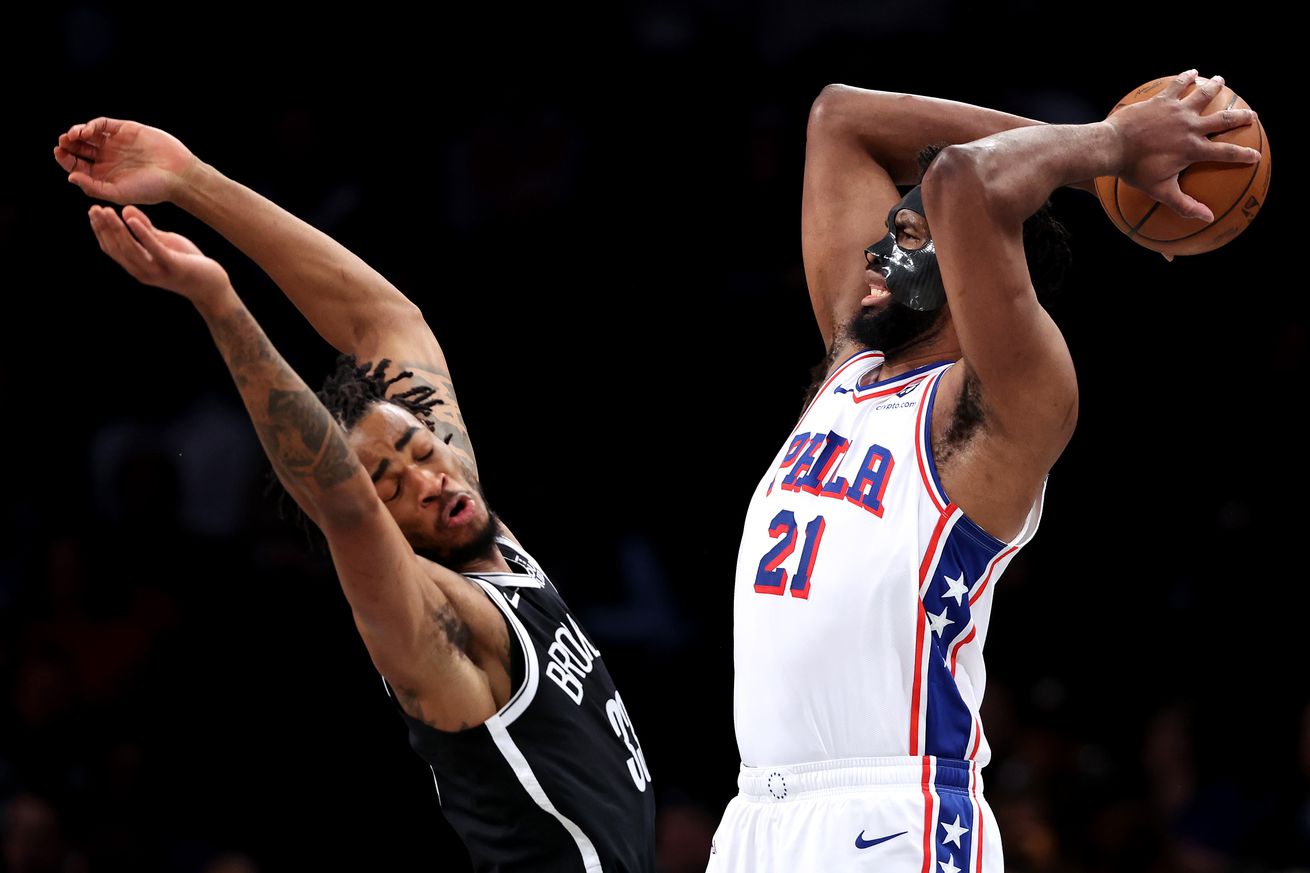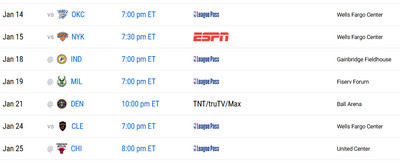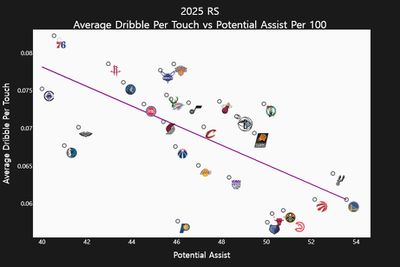
As a season defining 10 days approaches, we must hope that what happened in Sacramento stays in Sacramento.
It’s now but a footnote after the Philadelphia 76ers beat the Brooklyn Nets 123-94 on Saturday night, but the team couldn’t score for the opening two minutes. Three empty Philadelphia trips saw Brooklyn run out to an 11-0 lead. Yes, Philly quickly diminished it. They made light work of a team that wanted to lose, building up a lead as big as 30 points and keeping it.
But that scoreless stretch to start proceedings looked all too familiar. Recently, the team has shown a remarkable capability for stagnant and ugly offense. The worst such run of the season came with three and a half minutes to go in the fourth quarter against Sacramento. After Tyrese Maxey stole the ball and laid it in on the other end, the team would fail to score for the rest of the game, conceding a 15-0 run.
Here are the Sixer’s offensive possessions that followed Maxey’s layup:
- Paul George turnover
- Shot-clock violation
- Yabusele missed three
- Gordon missed three
- Maxey turnover
- Maxey missed floater
- George turnover
- Kyle Lowry turnover
- Maxey missed three
That’s five turnovers and four missed shots — nine straight empty possessions.
Quick thread on the good and bad of Philly’s offense in recent stretch:
We’ll start with the absolute worst – the Sacramento ending.
Minimal ball movement (just six non-handoff passes made in halfcourt live action) led to 0 points in three minutes of game time.
(sped up for vid length reasons)
Not to fret though, the team played the very next night at Golden State. This time with Joel Embiid in a nationally televised game. Fires in the belly and all that. Here’s how the first three and a half minutes of that game went:
- Paul George turnover
- Maxey made floater
- Embiid turnover
- Lowry layup blocked
- George missed three
- Caleb Martin missed three
- Maxey turnover
- Lowry missed three
- George made layup
- Embiid missed three
- George turnover
That’s four turnovers, six missed shots, and two made shots. The Sixers would only score points on back-to-back possessions once in that first quarter.
Combining the above two ‘runs’, in seven minutes of consecutive game time, the team had nine turnovers, 10 missed shots, and just two makes, one of them being a 4-on-2 fast break layup — 19 wasted possessions. Nineteen.
That’s not great. But I only point it out because the team has been phenomenal in the past 10 games. They’ve gone 7-3, with that hallmark Christmas Day win over the Boston Celtics garnering the most hope the team has earned all season. Embiid, Paul George and Maxey are finally playing at the same time, and role players like Caleb Martin and Kelly Oubre Jr. seem to be settling in and providing what Daryl Morey envisioned. Philadelphia’s presence is finally being felt in the league.
But this month of January will be a defining one for the team — a Rocky Balboa-esque test of endurance and greatness. From Jan. 14 to Jan. 25, Philadelphia will play the Oklahoma City Thunder, New York Knicks, Indiana Pacers, Milwaukee Bucks, Denver Nuggets, and Cleveland Cavaliers. That’s four of the top five champion contenders and the three MVP favorites. All in 10 days, with three back-to-backs in that stretch (Philly plays Chicago the day after the Cavs matchup, so I’m including that).
It’s a stretch that ain’t all sunshine and rainbows. It’s a very mean and nasty stretch and I don’t care how good the offseason was — it will drop them to the lottery if they let it. It’ll hit them hard, as the season has already, but it’s about how hard they can get hit and keep moving forward. That’s how winning is done!

How winning is not done is whatever that clutch Sacramento offense was. Not counting inbound or backcourt passes, the 76ers completed just six passes and five handoffs in that scoreless end (from 3:34 of the fourth quarter). That’s about a quarter of a quarter, so, if we extrapolate that to a real game we get just 96 passes (6 x 4 = 24, 24 x 4 = 96). Include the handoffs and it’s 176 a game. The lowest number of passes a team makes per game, according to NBA Tracking data, is 263.9 (Houston Rockets).
It’s a stretch that illustrates one of the staples in the forehead of Philly’s offense: they don’t share the ball with intention. They are last in the NBA in assists and assist-to-pass % (percentage of passes that end up in assists), second to last in potential assists and points created off assists, and third last in assists adjusted (the total sum of a team’s assists, free throw assists, and secondary assists, as defined by the NBA). As we can see in the below chart, Philly prefers dribbling over creating scoring opportunities from passing.

NBAVisuals.com
It’s understandable with incredible isolation players like Maxey, George and Embiid. When you need a bucket, give it to a guy who is one of the best in the world at doing it. But we saw the obvious drawback of that philosophy under the bright light of Sacramento’s famous beam. It’s easy to defend, all the defenders can hone in on the guy with the ball and force him to produce brilliance. If he doesn’t, it’s a missed shot or a turnover.
It’s even more frustrating to watch those isolation possessions knowing the team is capable of gorgeous basketball. Peak basketball, even. 2014 Spurs, the beautiful game, passing, moving, good shot for a great shot. Basketball as intended.
Early in the Sacramento game, eight passes were made on one possession before a Caleb Martin three. It likely would’ve been nine if he didn’t fumble a catch as PG was wide open right next to him.
There were just three passes on a Ricky Council IV missed jump shot, but the ball traveled from just inside the halfcourt line, to the left break and into the paint, to the opposite break, and then to the near corner — all in about three seconds.
There were five passes before a Guerschon Yabusele missed three, but again, the ball saw all corners of the halfcourt.
There was just one singular pass for an Eric Gordon made three. But it was a skip pass to an open man in the opposite corner. It’s a selfless pass with immediate shot intention. That’s far harder to defend than a handoff for an iso or a pass to set up a handoff that sets up a handoff for an iso.
Those setup passes are important, the ball moving is always important. The defense moves, unable to hone in on one sole dribbler, forced to scramble across the canvas, at the whim of the full size of the halfcourt and all five offensive players.
The team is capable of gorgeous ball movement. They did so in the Sacramento game!
The pill got to explore every corner of the halfcourt. It doesn’t always have to be 100 passes in a possession, just one right pass works.
But when they make multiple quick passes it does look good. Real good.
But they don’t have to play a brand of basketball that would be soundtracked by Mozart. The beauty of their Big 3 is their compatibility. In simple terms, Maxey is a speedy ball handler, George is a muscly yet smooth wing, Embiid is an overpowering interior force, and all of them can shoot. They’ve now played in 10 games together and their basketball suitability is finally starting to manifest.
After Embiid checked in with around six minutes to go in the second quarter against Golden State, Philadelphia scored on six straight offensive possessions. Embiid ran a high pick-and-roll with PG or Maxey on four. In the other two, he grabbed an offensive rebound and then had the ball at the top of the key before getting to the line, and scored off a low post possession.
It’s not as pretty as the above ball movement, nor is it particularly inventive, but it is a far better use of your talent than what that Sacramento crowd bore witness to.
They had a pitiful start against Golden State, but Philly’s big 3 had an effective stretch in the second.
The team scored on six straight possessions. For four of those, it was a high pick and roll with Embiid and Maxey or George.
Not perfect or insanely creative, but it creates advantages.
We saw beauty against Brooklyn too. There were three possessions to close the first half that played off Embiid’s interior threat. The first led to a Caleb Martin open dunk, the second to a PG open three, and the third to a PG open midrange. All three scoring levels were utilized in an extraordinarily simple manner.
And the basketball Gods noticed. Embiid’s first bucket of the second half came from an electric two-man sequence with Maxey. A pick-and-roll between the two had Brooklyn scrambling, Embiid added flair by going between his legs for a pass back to his co-star. Maxey then attempted a bounce pass to Yabusele, but the hoop deities disagreed, instead bouncing the ball off a Brooklyn defender’s foot, right into Embiid’s hands for the easy bucket, the karmic bucket.
And the stretch to end the first half of the Brooklyn Blowout was noice.
Embiid playmaking from paint for a Caleb Dunk, setting a highball screen for a PG three, and an off-ball low screen for a PG middy.
Hoop gods rewarded them with that Maxey Embiid two-man sequence (ball bounced off BKN foot)
The team has a run of easy games before the Balboa stretch mentioned above (next three games are at home vs. Phoenix, New Orleans and Washington, before a roadtrip to Orlando). If they can continue to play off each other and avoid the comfortability of the mundane offense, they’ll be in peak shape for it. In a seven-month-long season, it’s hyperbolic to call any 10 days a fateful segment. But this one is as important as it gets. Let it be more Brooklyn than Sacramento. Let that 2-12 season start be but a footnote. Let that ball move.